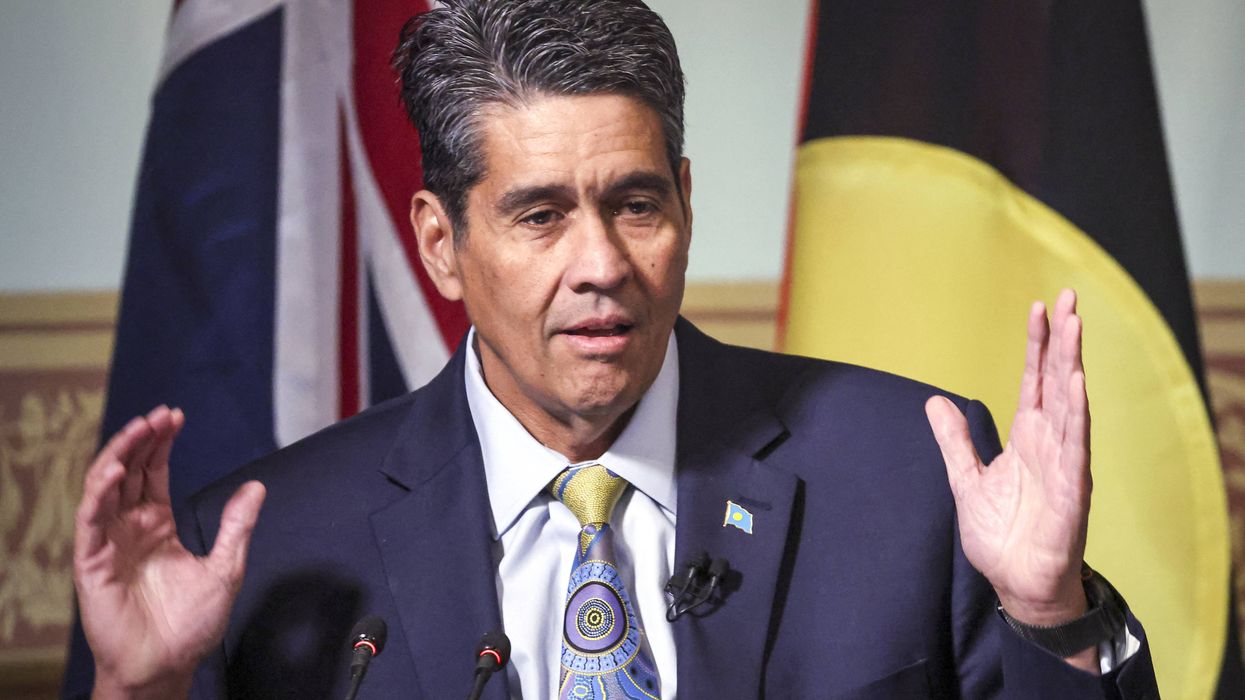October, 12 2021, 04:13pm EDT

EWG Study: Almost 42,000 Sources of Toxic 'Forever Chemicals' Could Be Polluting Surface or Drinking Water Across the U.S.
Investigation offers framework for testing to urgently identify highest risk areas
WASHINGTON
A new study by Environmental Working Group scientists finds almost 42,000 potential sources of the toxic "forever chemicals" known as PFAS that could be polluting surface water or drinking water in communities across the U.S.
The study bolsters EWG's long-running calls for strict PFAS regulations, in addition to more testing.
PFAS pollution affects all communities, from the affluent to those near the fence lines of industrial facilities. More work is urgently needed to identify areas where residents might face greater health risks from contaminated water.
EWG researchers analyzed potential sources of PFAS contamination in drinking water supplies nationwide, using public data from the Environmental Protection Agency's Enforcement and Compliance History Online database.
The facilities that appeared most often as possible sources were solid waste landfills, wastewater treatment plants, electroplaters and metal finishers, and petroleum refiners.
The analysis was published in a special issue of the American Water Works Association Water Science journal featuring the latest PFAS research.
PFAS are called forever chemicals because they build up in our bodies and never break down in the environment.
"It is critical that the EPA start regulating PFAS - now," said David Andrews, Ph.D., the lead author of the study and a senior scientist at EWG. "Every community in the U.S. is likely affected by PFAS contamination, but those living near or downstream from industrial facilities may be more at risk.
"Our investigation identifies a huge number of potential sources of contamination. It also provides a framework for deciding where and what to test so we can end releases into the environment," Andrews added.
In March, EWG-commissioned tests of tap water samples from throughout Northern Virginia revealed PFAS contamination at levels significantly higher than those previously reported for other parts of the Washington, D.C., metro area.
Valuable case studies of data available from California and Michigan show that PFAS contamination is common at many different types of sites and that widespread testing for PFAS in wastewater is crucial.
"The results from states like Michigan show there is a wide variety of sources of PFAS in surface water," said Andrews. "Many landfills and industrial sites release PFAS at detectable concentrations that may exceed state limits or health guidelines for PFAS in water.
"It is urgent that ongoing releases of PFAS be identified. We need to stop non-essential uses of PFAS and use filters to reduce these compounds from out water," he said.
Industrial PFAS discharges in Michigan have gone down substantially as a result of widespread testing, permitting of discharges and added treatment. In 2018, state officials set water quality standards for PFOA and PFOS, the two most notorious PFAS compounds, for discharges into drinking water supplies.
State law prohibits releases from wastewater utilities of more than 420 parts per trillion, or ppt, for PFOA and 11 ppt for PFOS.
Results from tests of water downstream from manufacturing facilities and from PFAS users across the U.S. revealed many previously unknown PFAS, which confirmed the need for broad testing of industrial facilities across the entire class of PFAS compounds.
PFAS are among the most persistent toxic compounds in existence, contaminating everything from drinking water to food, food packaging and personal care products. They are found in the blood of virtually everyone on Earth, including newborn babies.
Very low doses of PFAS chemicals in drinking water have been linked to suppression of the immune system and are associated with an elevated risk of cancer, increased cholesterol, and reproductive and developmental harms, among other serious health concerns.
Reducing PFAS levels in surface water and drinking water remains a nationwide challenge. But it's one that can be met through comprehensive tests of surface water and drinking water, along with tests of wastewater from potential PFAS sources.
The Biden administration also needs to use the EPA's powers to regulate as many industrial categories of PFAS discharges as possible.
"We need to turn off the tap of PFAS pollution from these industrial discharges, which affects more and more Americans every day. That's the first step," said Scott Faber, EWG's senior vice president for government affairs.
"The second step is for the EPA to set a national PFAS drinking water standard. And the third is to clean up legacy pollution," Faber added.
The EPA's proposal to regulate some industrial discharges of PFAS into our drinking water falls short of what's needed to end the pollution flowing from companies. EWG's new research shows that the contamination is likely even more widespread across the U.S. than has been confirmed, further underscoring the need for swift regulatory action.
The Environmental Working Group is a community 30 million strong, working to protect our environmental health by changing industry standards.
(202) 667-6982LATEST NEWS
'Unhinged' Trump Wishes 'Merry Christmas to All, Including the Radical Left Scum'
"Nothing more Christian than to be a hateful wretched fuck on Jesus’ birthday," quipped one critic.
Dec 25, 2025
In a message called typically on-brand by observers, US President Donald Trump wished "Merry Christmas to all"—including his political opponents, whom he described in decidedly unchristlike language.
"Merry Christmas to all, including the Radical Left Scum that is doing everything possible to destroy our Country, but are failing badly," Trump said Christmas Eve on his Truth Social network.
"We no longer have Open Borders, Men in Women’s Sports, Transgender for Everyone, or Weak Law Enforcement," the president added. "What we do have is a Record Stock Market and 401K’s, Lowest Crime numbers in decades, No Inflation, and yesterday, a 4.3 GDP, two points better than expected. Tariffs have given us Trillions of Dollars in Growth and Prosperity, and the strongest National Security we have ever had. We are respected again, perhaps like never before. God Bless America!!!"
While nothing new—Trump has used past Christmas messages to tell people he doesn't like to "go to hell" and "rot in hell"—observers, including some MAGA supporters, were still left shaking their heads.
"Radical Left Scum" 😂🤣😂🤣😂🤣Christmas greetings from a liar, traitor, pedophile, and overall shitstain upon society.
[image or embed]
— Bill Madden (@maddenifico.bsky.social) December 24, 2025 at 9:00 PM
"Nothing more Christian than to be a hateful wretched fuck on Jesus’ birthday!" liberal political commentator Dean Withers said on X.
Another popular X account posted: "A sitting president of the United States using Christmas Day to spew venom at fellow Americans he calls 'Radical Left Scum' isn’t just unpresidential—it’s unhinged, un-Christian, and utterly beneath the office."
"This is the behavior of a bitter, small man who can’t even pretend to unify for one holy day," she added. "Shameful. Disgraceful. Pathetic."
Keep ReadingShow Less
Palau Signs Controversial $7.5 Million Deal to Take 75 Trump Deportees
"What if we spent the $100,000 per person in America setting them up with housing assistance, healthcare, education, etc?" asked one critic.
Dec 25, 2025
Palau said Wednesday that it has agreed to take in up to 75 people deported from the United States during President Donald Trump's purge of unauthorized immigrants in exchange for millions of dollars in financial assistance—a move that has sparked considerable opposition among the Pacific archipelago nation's roughly 18,000 inhabitants.
The office of Palauan President Surangel Whipps Jr. announced a memorandum of understanding with the United States under which the country will receive $7.5 million in assistance in exchange for taking in 75 third-country deportees who cannot be repatriated to their countries of origin.
Earlier this week, US State Department Principal Deputy Spokesperson Tommy Pigott said the people who will be sent to Palau have “no known criminal histories," as is the case with the vast majority of unauthorized immigrants in the United States, who have committed no crime other than the mere misdemeanor of entering the country illegally.
However, Palauans have voiced concerns over US Secretary of State Marco Rubio's remarks during a Cabinet meeting earlier this year in which he said that, “We want to send some of the most despicable human beings—perverts, pedophiles, and child rapists—to your countries as a favor to us."
Whipps said Wednesday that the relocation plan involves “people seeking safety and stability."
“These are not criminals,” the president said during earlier debate on the proposal. “Their only offense was entering the United States illegally and working without proper permits.”
However, Palau's Congress and its influential Council of Chiefs have twice rejected the transfers.
Piggot's statement "highlighted US commitments to partner with Palau on strengthening the country’s healthcare infrastructure, increasing Palau’s capacity to combat transnational crime and drug trafficking, and bolstering Palau’s civil service pension system."
Palau, which was administered by the US from 1947-94 and is now associated with the United States under the 1994 Compact of Free Association, which guaranteed the country nearly $900 million economic aid over 20 years in exchange for exclusive US military access.
The country's foreign policy often tracks closely to that of the US. For example, Palau is sometimes among the handful of usually similarly small nations that vote along with the United States and Israel against United Nations resolutions condemning Israeli crimes or affirming Palestinian rights.
Other developing nations including Eswatini, Rwanda, South Sudan, and Uganda have also agreed to take in US deportees or are considering doing so.
Reactions to the US-Palau agreement drew criticism on social media, where one X user called the deal a "bribe" and another popular Bluesky account asked, "What if we spent the $100,000 per person in America setting them up with housing assistance, healthcare, education, etc?"
Keep ReadingShow Less
Trump 'Choosing From the War Crimes Menu' With 'Quarantine' on Venezuela Oil Exports
"Economic strangulation is warfare and civilians always pay the price," lamented CodePink.
Dec 25, 2025
President Donald Trump has ordered US military forces to further escalate their aggression against Venezuela by enforcing a "quarantine" on the South American nation's oil—by far its main export—in what one peace group called an attempted act of "economic strangulation."
"While military options still exist, the focus is to first use economic pressure by enforcing sanctions to reach the outcome the White House is looking [for]," a US official, who spoke on condition of anonymity, told Reuters.
The move follows the deployment of an armada of US warships and thousands of troops to the region, threats to invade Venezuela, oil tanker seizures off the Venezuelan coast, Trump's authorization of covert CIA action against the socialist government of Venezuelan President Nicolás Maduro, and airstrikes against boats allegedly running drugs in the Caribbean Sea and Pacific Ocean that have killed more than 100 people in what critics say are murders and likely war crimes.
This, atop existing economic sanctions that experts say have killed tens of thousands of Venezuelans since they were first imposed during the first Trump administration in 2017.
"The efforts so far have put tremendous pressure on Maduro, and the belief is that by late January, Venezuela will be facing an economic calamity unless it agrees to make significant concessions to the US," the official told Reuters.
The official's use of the word "quarantine" evoked the 1962 Cuban Missile Crisis, an existential standoff that occurred after the John F. Kennedy administration imposed a naval blockade around Cuba to prevent Soviet nuclear missiles from being deployed on the island, even as the US was surrounding the Soviet Union with nuclear weapons.
"This is an illegal blockade," the women-led peace group CodePink said in response to the Reuters report. "Calling it a 'quarantine' doesn’t change the reality. The US regime is using hunger as a weapon of war to force regime change in Venezuela. Economic strangulation is warfare and civilians always pay the price. The US is a regime of terror."
Critics have also compared Trump's aggression to the George W. Bush administration's buildup to the invasion and occupation of Iraq, initially referred to as Operation Iraqi Liberation (OIL). But unlike Bush, Trump—who derided Bush for not seizing Iraq's petroleum resources as spoils of war—has openly acknowledged his desire to take Venezuela's oil.
"Maybe we will sell it, maybe we will keep it,” he Trump said on Monday. “Maybe we’ll use it in the strategic reserves. We’re keeping the ships also.”
On Wednesday, a panel of United Nations experts said that the US blockade and boat strikes constitute "illegal armed aggression" against Venezuela.
Multiple efforts by US lawmakers—mostly Democrats, but also a handful of anti-war Republicans—to pass a war powers resolution blocking the Trump administration from bombing boats or attacking Venezuela have failed.
The blockade and vessel seizures have paralyzed Venezuela's oil exports. Ports are clogged with full tankers whose operators are fearful of entering international waters. Venezuela-bound tankers have also turned back for fear of seizure. Although Venezuelan military vessels are accompanying tankers, the escorts stop once the ships reach international waters.
According to the New York Times, Venezuela is considering putting armed troops aboard tankers bound for China, which, along with Russia, has pledged its support—but little more—for Caracas.
Keep ReadingShow Less
Most Popular


